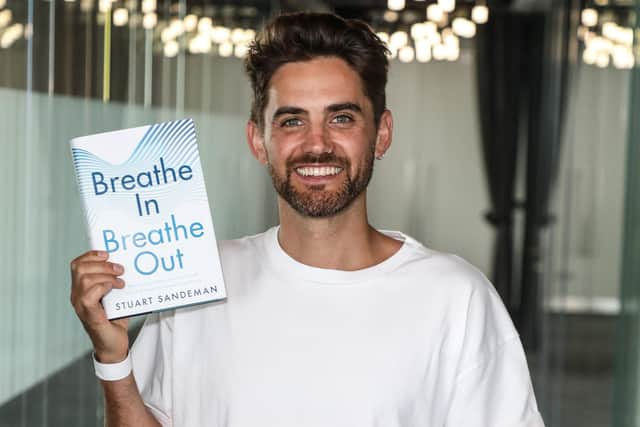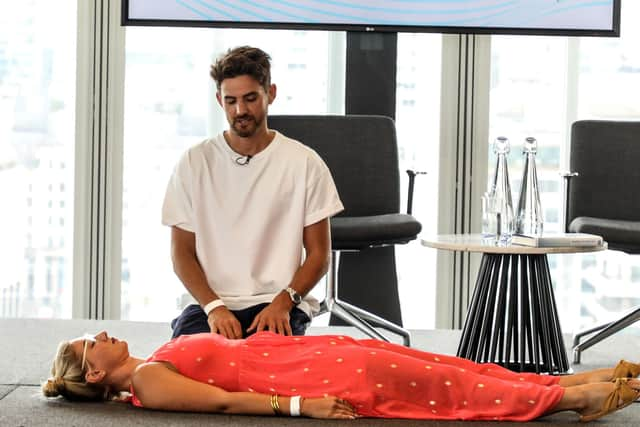Learn how to breathe better with Stuart Sandeman's new book
When I arrive at the Royal Botanic Garden to interview Stuart Sandeman, the author of new book, Breathe In, Breathe Out, I’m feeling slightly suffocated.
After a stressful journey on a hot and heavily delayed bus, thanks to the city being on the cusp of the Edinburgh Festival, my breathing is shallow and fast. In contrast, Sandeman, 39, is the master of his oxygen intake - shoulders back and thriving, like one of the well respirated trees in the lush summery gardens.
Advertisement
Hide AdAdvertisement
Hide AdHe grew up in Edinburgh, is founder of company Breathpod and has made wellness cool, thanks to his Decompression Sessions show on Radio 1.


“The last thing I thought I’d ever be doing is writing a book about breathing, but my background has taken a few twists and turns,” says Sandeman.
Indeed, his resume includes a spell as a professional in the Scottish Judo Team, until he slipped a disc at 19.
After that injury, he studied maths, before taking a career in finance for eight years.
“I was working in Hong Kong, but in Japanese markets, when the tsunami hit Japan in 2011,” he says. “I went over, while everyone was evacuating, because my work said I had to ‘show face’ to my clients, then there was another massive earthquake when I was there. It shook me up, and I wondered if I was really fulfilled at work”.


Sandeman took a year off to pursue his musical passion and ended up touring the world as a DJ.
At the same time, in 2015, his girlfriend, Tiff, 30, was diagnosed with terminal cancer.
“That ignited the Judo player - how do we beat this thing?” he says.
Advertisement
Hide AdAdvertisement
Hide AdSadly, despite trying everything - conventional and alternative - Tiff died six months later.
“If someone had told me to ‘breathe’ during that time, I think I would’ve stuck my fingers up and told them to speak some sense,’” he says.
As he attempted to navigate grief, he moved back to Scotland, temporarily lost interest in music, and generally struggled with bottled-up emotion.
It was taking his mum, as a Mother’s Day gift, to an Edinburgh breathing workshop that signalled a breakthrough, and ignited the interest in his subject.
“Something magic happened,” says Sandeman, who was initially cynical about the session. “It felt like the weight of grief was pulled off me, and that my girlfriend who’d passed away was there holding my hand. I thought I’m going mad, or someone has spiked my drink. Either that, or there was something special that I’d overlooked - this power that we all have to tap into. I wanted to see if it was a one off, or something I could explore further”.
And he did. In fact, he hasn’t really stopped.
He’s fascinated by how we can use breathing to manage trauma, stress response, energy levels, to quieten the “tiger in your head” and even improve athletic performance.
He says he can help us to make our own natural version of EPO - the drug that Lance Armstrong allegedly took to win the Tour de France multiple times - by breathing. “But it’s completely legal,” he says.
He’s had lots of positive endorsement, including that of his researcher and psychiatrist mentor, Dr Norman Rosenthal MD, who, the book details, burst into tears after a session with Sandeman.
Advertisement
Hide AdAdvertisement
Hide AdI certainly feel more conscious of my shonky breathing activities after reading his new book, in which he describes humans as “pugs of the primate world”. That’s me. It also contains diagnostic tools, with diagrams, and I identify with The Chest Breather - “one of the most common ones”.
Apparently, we should all be using our diaphragms, and breathing lower down, so our stomachs rise. Also, mouth respiration is strictly forbidden, as covered in the chapter Shut Your Mouth and Slow Things Down. Sandeman explains that, when you inhale through your nostrils, your sinuses release nitric oxide, which is a vasodilator, antibacterial and antiviral, among other things. In contrast, when you breathe through your mouth, it can cause sleep apnea, raises the levels of carbon dioxide and “rings the alarm bells” to trigger anxiety.
If you struggle with nose breathing, he recommends sticking one strip of micropore medical tape over your mouth.
Although you might feel like you’re in a hostage situation, presumably you’ll get used to it.
This manual is a very convincing read - “empowering” as Sandeman says - with details of the clients he’s helped over recent years.
It also bridges that gap between New Age-ish and scientific evidence-based work. “I think there’s magic on both sides,” he says.
Breathe In, Breathe Out contains easy exercises, and unlike some of the wellness industry’s expensive snake oil, breathing is free, so you need zero equipment (well, apart from the book).
Before I leave, we do an exercise together. Sandeman presses play on some twinkly electronic music.
Advertisement
Hide AdAdvertisement
Hide AdWe follow the oxygen “through the airwaves and down our throats”, noticing where the air travels first by placing one hand on the chest, the other on the belly. Mine is definitely localised at the top, so I try working the diaphragm, by breathing “almost into your hips”.
I inhale into my stomach area first, counting for five, then out for the same. Next, I’m instructed to breathe in for four counts, hold for four, and exhale for eight, while dropping my shoulders and relaxing my jaw, before repeating a few times.
“Notice this wave of calm flow over you.” Indeed. It’s as easy as that.
Before I go, I pick up my copy of his new book. He signs it; “Remember to breathe, Stuart x”.
Breathe In Breathe Out by Stuart Sandeman, £16.99, HarperCollins
Comments
Want to join the conversation? Please or to comment on this article.